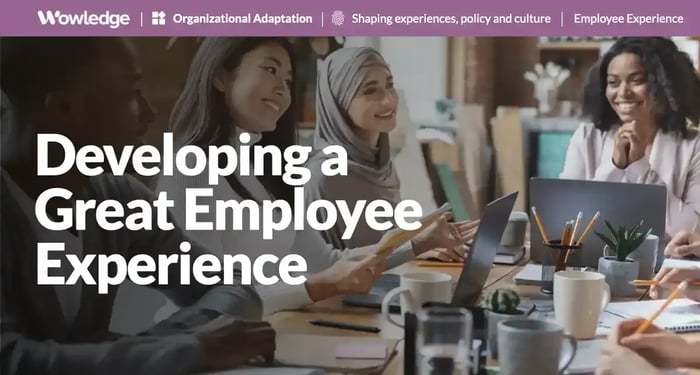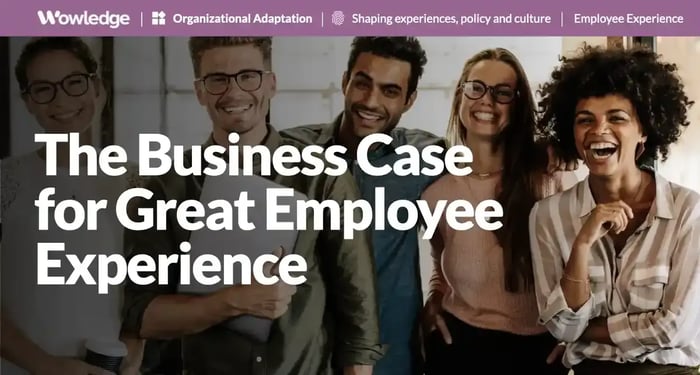Table of Contents
Developing a great Employee Experience (EX) refers to the building of an employee's overall journey and interactions with your organization throughout their employment lifecycle. It encompasses all the touchpoints and experiences an employee has from joining the company until they leave or retire.
Employee Experience focuses on creating a positive and engaging work environment that fosters productivity, satisfaction, and overall well-being. It involves various aspects, including the physical work environment, the company culture, the relationship with managers and colleagues, opportunities for growth and development, work-life balance, and the tools and technologies provided to perform tasks efficiently.
Why is employee experience important?
“If you are lucky enough to be someone's employer, then you have a moral obligation to make sure people look forward to coming to work in the morning.”
- John Mackey, Former CEO of Whole Foods Market
Yes, it’s true, and disengaged employees can negatively impact an organization’s bottom line. Employee experience (EX) impacts job satisfaction, productivity, attracting talent, and retention; that value is borne out in quantitative research. But beyond the “ROI,” companies should take a page from John Mackey’s book. Developing a positive employee experience should be viewed as a moral obligation.
While employee experience has always been important, it is especially true nowadays. While a paycheck may meet basic physiological needs, people need more than compensation. When work is just a paycheck, employees’ total needs are not being met. Employees want to feel engaged and connected to a company. Companies need to be intentional about their journey to get employees to reach self-actualization.
A Word About Customer Experience (CX)
Find an organization struggling to deliver exceptional customer experiences, and you’ll often find a workplace environment with a negative employee experience. No company can realistically expect employees not excited to work for the brand to exceed customers’ expectations. Building a great employee experience is foundational to a great customer experience.
“Customer experience and employee experience are now two of the driving forces of business. Independently, each function leads to valuable relationships—with customers and employees—but when CX and EX are managed together, they create a unique, sustainable competitive advantage. Companies should consider integrating the two disciplines and installing a Chief Experience Officer to lead the combined effort across the organization.”
- Denise Lee Yohn, Harvard Business Review, June 13, 2019

Employee experience is the journey and the destination
Developing a great employee experience can be broken down into the major milestones or stages of an employee’s time at a company. How companies approach EX will vary at different stages of employment. The critical areas in an employee’s journey include:
- Onboarding: The employee's initial experience when joining the organization, including orientation, training, and familiarization with company policies, values, and culture.
- Work Environment: The physical space, office layout, amenities, and resources available to employees to support their productivity, comfort, and collaboration.
- Company culture: The shared values, beliefs, and behavior expectations that shape the work environment. A positive culture promotes inclusivity, respect, transparency, and belonging.
- Communication: Effective and transparent communication channels that enable employees to stay informed, share feedback, and engage with colleagues and leaders.
- Performance management: Clear expectations, regular feedback, and recognition programs that help employees understand their goals, progress, and organizational contributions.
- Learning and development: Opportunities for employees to enhance their skills, acquire new knowledge, and grow professionally through training programs, mentoring, coaching, and career advancement paths.
- Work-life balance: Policies and practices that support a healthy balance between work and personal life, such as flexible working hours, remote work options, and employee wellness programs.
- Employee wellness: Initiatives that promote physical, mental, and emotional well-being, including access to healthcare resources, mental health support, stress management programs, and work-life integration.
- Technology and tools: The tools, software, and technology infrastructure provided to employees that are necessary to perform their tasks efficiently, collaborate effectively, and streamline processes.
- Employee feedback and engagement: Regular feedback mechanisms, surveys, and platforms which allow employees to provide input, voice concerns, and participate in decision-making.
By prioritizing and investing in developing a great employee experience, organizations can create a positive and engaging work environment that attracts and retains top talent, enhances productivity and performance, fosters employee satisfaction and loyalty, and ultimately contributes to overall success.

Putting the cart before the horse
Before thinking about mapping the employee journey however, a solid foundation is critical. A company must have a clearly defined mission, vision, values, and purpose. Here is a quick review of what they are:
Mission
A company uses a mission statement to explain its reason for existence in simple and concise terms. The statement is generally a single sentence or a short paragraph. Mission statements serve several purposes, including motivating employees and reassuring investors of the company's future. A mission statement might overlap with other marketing content, but it differs from a vision statement, value statement, brand, or slogan.
Vision
A company's vision statement expresses its purpose by defining its primary long-term goals. A company vision statement aligns with an organization’s mission, strategic plan, culture, and values. Vision statements are inspirational and aspirational. They motivate employees to work towards a shared “vision” while explaining the company’s future direction to all stakeholders.
Values
Values represent a company’s DNA and help it differentiate itself from the competition. They represent the organization’s principles or standards of behavior, its judgment of what is most important or useful to guide employee conduct. The core company values shape a company culture and impact its business strategy. They allow the organization to create a purpose, improve team cohesion, and create a sense of commitment in the workplace.
Purpose
A company's purpose refers to its reason for existence beyond solely making profits. It encompasses the broader impact and contribution a company seeks to make in society beyond its core products or services. While the specific purpose can vary between companies, it typically involves addressing societal or environmental challenges, creating value for stakeholders, and fulfilling a meaningful mission.
Together mission, vision, values, and purpose define an organization’s “North Star”. A strong foundation is essential before embarking on a tremendous and exceptional employee experience. Everything from the employee value proposition (EVP), performance management, employee development and offboarding processes must be aligned with the North Star.
Measure twice, cut once
Developing a great employee experience fails when organizations don’t understand the “ground truth.” Knowing what is on employees’ minds from the C-suite to individual contributor is critical. Feedback from employees will help companies understand how they feel about the organization. Formal data gathering through surveys is a start, but far too often, companies rely only on annual engagement surveys, which, at best, are a snapshot of how employees feel. Easily manipulated and routinely not acted upon, yearly engagement surveys should be only one of many tools for measuring where employee perceptions are at.
There is a need for an open conversation with employees. The concept is to create an environment that values employee opinions so that they can be honest and open with the company.
Attendance, productivity, and turnover rates all help reveal how employees feel. High absenteeism, low productivity, and high turnover rates can also indicate that an employee experience isn’t healthy. Using all the data available is an essential element of improving the experience and help verify if company efforts are working.
Where should a company start on employee experience?
With its North Star defined and employee experience and sentiment measured, companies can focus on the areas that affect and shape their employees' journey. Four key steps include:
1. Listen to employees
Employee surveys and conversations are essential tools for employee experience planning. The insights from these employee listening approaches should be used as a guide for improving the experience. Trends and areas of improvement should be assessed as opportunities.
“Employees logically expect transparency, authenticity, simplicity, and relevance. They expect an experience that delivers on a compelling employer brand promise and the expectations it sets.”
– Lisa Morris & Rob Sherrell
2. Prioritize the pain
Once the areas that employees report needing most for a better experience are identified, those should be prioritized. In particular, target the problem areas that interfere the most with the relevant touchpoints and moments that matter most for a positive employment experience.
3. Get the leaders on the bus
The best change management planning lives and dies with a leadership team. Unless top leaders understand and support the employee experience effort, implementing any plan will be an uphill battle. Leadership teams have a significant impact on the employee experience. Helping them understand their role in how employees feel about the company will make the process better for everyone. Giving the leadership team ownership over various parts of an employee experience improvement plan can help get them on board. Developing a robust employee experience requires top leadership support and engagement.
4. Put employees first
Companies need to be profitable and have high customer satisfaction, but putting employees first often helps get those results. When making decisions, think about how they will impact the employees. For example, encourage employees to take PTO (personal time off) and work on their mental health to be more productive, or improve the diversity and inclusion programming to make all employees feel valued.
Once an organization has measured the employee experience, it can improve it. Here are some ways to improve the employee experience.

Improving employee experience
Onboarding
Creating a great employee experience starts by developing a structured onboarding program with a comprehensive plan that covers all essential aspects, such as new hire paperwork, company policies, job expectations, and training. A structured program ensures consistency and provides a clear roadmap for new employees.
It’s important to know that an employee’s experience with a company starts before their first day. Engaging with new hires before their first day involves providing them with relevant information, welcome messages, and any necessary pre-employment tasks. This helps them feel valued and prepared for their new role.
- Assign a mentor or buddy: Pair new employees with an experienced colleague who can serve as a guide to the company culture, facilities, practices, and resources.
- Optimize new hire orientation: Dedicate time to introduce new hires to the company's mission, values, history, organizational structure, and key personnel. It helps them understand the bigger picture and how their role contributes to the organization's success.
- Offer comprehensive training: Develop a comprehensive training program that covers job-specific skills, tools, and systems. Balance theoretical knowledge with practical hands-on training to ensure new employees feel confident in their abilities.
- Set expectations and goals: Communicate performance expectations, job responsibilities, and key performance indicators. Align goals with the broader organizational objectives and provide ongoing feedback and guidance.
- Foster connections: Facilitate opportunities for new hires to meet colleagues within their department and across the organization. Encourage social interactions, team-building activities, and networking events to build relationships and create community.
- Automate administrative tasks: Streamline administrative processes by utilizing technology and automation tools. This reduces paperwork, simplifies workflows, and allows new hires to focus on meaningful tasks and building relationships.
A successful onboarding process goes beyond the first few days or weeks. It should provide a solid long-term engagement, productivity, and retention foundation over the course of the first year.
Work Environment
Establishing a positive work environment can be one of the more costly EX initiatives. Not every company can have its physical spaces support its culture. However, it is essential to focus on areas and improve them where possible.
- Ergonomics: Ensure that workstations, desks, chairs, and equipment are ergonomically designed to support good posture, reduce strain, and promote comfort. Consider adjustable chairs, standing desks, ergonomic keyboards, and mice to minimize the risk of musculoskeletal disorders.
- Temperature and ventilation: Maintain a comfortable temperature range and proper ventilation in the workplace. Consider using programmable thermostats or individual climate control options to allow employees to adjust the temperature according to their preferences.
- Noise control: Use sound-absorbing materials, acoustic panels, and carpeting to minimize excessive noise. Create designated quiet areas or provide noise-canceling headphones for employees who need a more peaceful environment to concentrate.
- Workspace personalization: Encourage employees to personalize their workspaces with plants, photos, artwork, or other items that contribute to their well-being and make the environment feel more comfortable and inviting.
- Break areas: Designate areas where employees can take breaks, relax, or engage in recreational activities. These spaces can have comfortable seating, recreational equipment, or games, promoting mental relaxation and social interaction.
- Cleanliness and organization: Maintain a clean and clutter-free workplace by implementing regular cleaning schedules and providing sufficient storage solutions. A well-organized environment enhances efficiency and reduces stress.
- Health and safety: Ensure compliance with health and safety regulations, such as proper signage, fire safety equipment, first aid kits, and emergency evacuation plans. Regularly assess and address potential hazards to create a safe work environment.
- Collaboration spaces: Create areas where employees can collaborate, brainstorm, or hold meetings. These spaces should have appropriate furniture, whiteboards, and audio-visual equipment to facilitate teamwork and innovation.
Involve employees by seeking their input and feedback regarding the physical work environment. Their insights and suggestions can help tailor improvements to their needs and preferences.
Organizational culture
Connecting the company culture to its mission, vision, values, and purpose is essential to developing a great employee experience. This defines an organization’s North Star and is the foundation on which all EX initiatives should be built.
- Alignment: Ensure the company culture reflects and reinforces the mission, vision, values, and purpose. Identify and articulate the desired cultural attributes that support these elements.
- Communication: Communicate the mission, vision, values, and purpose clearly to all employees. Reinforce the connection between these elements and the desired culture through various channels, such as company-wide meetings, internal communications, and training programs.
- Recruitment and onboarding: Incorporate the mission, vision, values, and purpose into the recruitment and onboarding processes. Hire individuals whose beliefs and behaviors align with the desired culture and reinforce the importance of these elements during the onboarding process.
- Leadership example: Leaders should embody the mission, vision, values, and purpose through their actions, behaviors, and decisions, serving as role models for employees. They play a crucial role in shaping the culture.
- Performance management: Incorporate the mission, vision, values, and purpose into performance management systems, including goal setting, feedback, and recognition. Evaluate and reward employees based on their alignment with these elements.
- Continuous reinforcement: Regularly assess and reinforce the connection between culture and the mission, vision, values, and purpose. Encourage open dialogue, provide opportunities for feedback, and adjust as needed to ensure alignment over time.
By integrating company culture with mission, vision, values, and purpose, organizations can create a cohesive and purpose-driven environment where employees are motivated, engaged, and aligned with the company's overarching goals.
Communication
Improving internal communications is a continual effort that requires commitment and consistent reinforcement.
- Establish clear communication channels: Determine the most effective channels for communication across the organization. This could include email, instant messaging platforms, project management tools, or internal social networks. Ensure that employees are aware of the designated channels for different types of communication.
- Foster an open and transparent culture: Encourage open dialogue and transparency across all levels of the organization. This can be achieved through regular team meetings, town halls, or open forums where employees can share ideas, concerns, and feedback.
- Provide regular updates: Keep employees informed about company news, initiatives, and progress. Use newsletters, internal blogs, or digital signage to share updates, important announcements, and successes. Regular communication helps create a sense of involvement and belonging.
- Streamline communication: Simplify and streamline communication processes to avoid information overload and confusion. Use concise and clear language in all communications and encourage brevity and clarity in written messages. Consider using templates, standardized formats, and guidelines to ensure consistent communication.
- Encourage face-to-face interaction: While digital communication is essential, face-to-face interaction should be addressed. Encourage in-person or video meetings whenever possible, as those allow for more nuanced communication, relationship building, and the opportunity to address concerns or questions in real-time.
- Implement collaboration tools: Utilize project management software, shared document repositories, or virtual whiteboards. These tools facilitate teamwork, centralize information, and allow real-time collaboration, regardless of employees' physical locations.
- Conduct employee surveys and feedback sessions: Regularly seek employee input through surveys, suggestion boxes, or feedback sessions. Gather insights about communication challenges, areas for improvement, and potential bottlenecks. Actively address the concerns and suggestions raised.
- Lead by example: Leadership is critical in setting the tone for internal communication. Leaders should communicate openly, be approachable, and actively listen to their teams. Encourage leaders to regularly share their expectations, goals, and progress updates to create a culture of transparency.
- Evaluate and adapt: Continuously evaluate the effectiveness of internal communication strategies. Monitor feedback, track key metrics like employee engagement, and adjust as necessary. Communication needs can evolve, so stay agile and adapt the approaches accordingly.
Investing in effective communication practices can enhance collaboration, productivity, and overall employee satisfaction within your company.
Performance management
Tying performance management to a company's mission, vision, and values is essential for aligning individual and team goals with the organization's overall strategic direction.
- Define clear objectives: Establish specific and measurable performance objectives that directly contribute to the company's mission, vision, and values. Ensure these objectives align with the organization's strategic priorities and long-term goals.
- Communicate expectations: Communicate the expectations associated with performance management to employees. Articulate how their individual goals and performance will directly impact the achievement of the company's mission, vision, and values. This helps employees understand the significance of their contributions and motivates them to align their efforts accordingly.
- Develop competency frameworks: Create competency frameworks that outline the skills, knowledge, and behaviors necessary for employees to embody the company's values and support its mission and vision. These frameworks provide guidelines for evaluating and developing employee performance in alignment with the organization's core principles.
- Leverage performance evaluation criteria: Establish criteria that reflect the organization's mission, vision, and values. These criteria should assess both individual results and the demonstration of desired behaviors and values. Incorporate key performance indicators (KPIs) and metrics that measure progress toward the company's strategic objectives.
- Deliver feedback and coaching: Provide regular feedback and coaching to employees, focusing on their performance regarding the organization's mission, vision, and values. Highlight areas of alignment and areas for improvement, emphasizing behaviors and actions that support the company's core principles. Encourage open dialogue and discuss how individual performance connects to organizational objectives.
- Offer recognition and rewards: Link recognition and rewards programs to demonstrating behaviors and outcomes that align with the company's mission, vision, and values. Celebrate and acknowledge employees who consistently exhibit the desired qualities and contribute significantly to the organization's success.
- Provide development and growth opportunities: Connect performance management with development and growth opportunities that further reinforce the alignment with the company's mission, vision, and values. Offer training programs, mentorship, and career advancement opportunities that support employees in acquiring the skills and competencies needed to contribute effectively to the organization's strategic goals.
By integrating performance management with the company's mission, vision, and values, organizations can create a culture of alignment, engagement, and continuous improvement, where employees understand how their work directly impacts the overall success and purpose of the organization.
Work-life balance
Ensuring employees' work-life balance is crucial for their well-being and overall productivity, requiring tapping into a diverse mix of strategies to ensure that the company promotes a healthy work-life balance.
- Flexible work arrangements: Offer flexible working hours, such as flextime or compressed workweeks, allowing employees to adjust their schedules to accommodate personal commitments and preferences.
- Remote work opportunities: Provide options for remote work or telecommuting, which can reduce commuting time and increase flexibility for employees.
- Clear communication and expectations: Communicate work expectations, deadlines, and priorities, ensuring that employees have a realistic understanding of their workload and can effectively manage their time.
- Vacation/time off: Encourage employees to use their vacation days and take breaks when needed. Promote a culture where time off is respected, and employees feel comfortable disconnecting from work during their time off.
- Employee Assistance Programs (EAPs): Implement EAPs that offer resources and support for employees facing personal challenges, such as counseling services, financial planning, and wellness programs.
- Wellness initiatives: Provide wellness programs, such as fitness classes, meditation sessions, or wellness challenges, to promote physical and mental well-being among employees.
- Supportive managers: Train and educate managers to support work-life balance and lead by example. Encourage managers to be understanding and empathetic, allowing for flexibility when necessary.
- Clear boundaries: Encourage employees to establish boundaries between work and personal life. Discourage excessive overtime and discourage the expectation of constant availability outside of regular working hours.
- Technology policies: Establish guidelines and policies regarding after-work communication to prevent employees from feeling pressured to respond to work-related messages or emails during non-working hours.
- Regular feedback and check-ins: Conduct regular performance evaluations and check-ins with employees to discuss their workload, challenges, and potential improvements in their work-life balance.
Regularly assess the effectiveness of the initiatives and gather feedback from employees to make necessary adjustments and improvements to tailor the most effective strategies to fit the company's unique evolving needs and culture.
Employee wellness
Improving employee wellness programs is essential for enhancing employees' overall well-being and satisfaction.
- Assess employee needs: Conduct surveys or focus groups to understand employees' specific wellness needs and preferences. This will help tailor the program to their requirements and make it more effective. Review data on absences, sick leave usage, work accident and illness reports, mental health benefits claims, etc.
- Comprehensive wellness approach: Develop a holistic approach to wellness that addresses various dimensions, including physical, mental, and emotional health. Consider offering programs focusing on stress management, nutrition, fitness, mental health support, work-life balance, and financial wellness.
- Leadership support: Ensure senior leadership actively supports and promotes the employee wellness program. Their involvement can encourage participation, create a positive culture around wellness, and set an example for others.
- Flexible work arrangements: Promote flexible work arrangements, such as remote work or flexible hours, to support work-life balance and reduce stress levels. This flexibility can contribute to better overall employee well-being.
- Health education and awareness: Provide regular educational resources and workshops on topics related to health and wellness. This can include seminars on nutrition, mental health, exercise, and stress reduction techniques. Promote awareness campaigns focusing on specific health issues or observances (e.g., Mental Health Awareness Month, World Heart Day).
- Mental health support: Create a supportive environment that acknowledges and addresses mental health. Provide access to mental health resources, such as counseling services, Employee Assistance Programs (EAPs), or mindfulness and meditation programs. Foster a culture of open communication and destigmatize seeking help for mental health concerns.
- Incentives and rewards: Offer incentives to encourage employee participation and engagement in wellness programs. These can include rewards, recognition, or gamification elements like badges or points systems.
- Work-life balance: Promote work-life balance by encouraging employees to take breaks, use their vacation time, and avoid excessive overtime. Implement policies that support flexible schedules, remote work, and parental leave.
- Evaluation and feedback: Regularly evaluate the effectiveness of your wellness programs through feedback mechanisms like surveys or focus groups. Use the insights gained to refine and improve the initiatives based on employee suggestions and needs.
Companies can create a healthier, happier, and more engaged workforce by continuously investing in and improving employee wellness programs.
Technology and tools
Much like improving the work environment, improving the technology and tools employees use in a company can be costly yet highly valuable to the employee experience. These costs promise a return on investment by increasing productivity and efficiency.
- Conduct a technology assessment: Evaluate the company's existing technology infrastructure, tools, and systems. Identify areas that need improvement or are outdated. Consider factors such as usability, functionality, efficiency, and scalability.
- Gather feedback from employees: Involve employees in decision-making by collecting feedback and insights on the current technologies and tools. Conduct surveys, interviews, or focus groups to understand their pain points, suggestions, and requirements.
- Set clear goals and objectives: Define the goals and objectives to be achieved by improving the technology and tools. For example, targets may be to enhance productivity, streamline processes, improve collaboration, or reduce costs. These goals will guide the decision-making process and help prioritize areas for improvement.
- Stay up to date with industry trends: Keep abreast of the latest technological advancements and industry trends relevant to your business. Subscribe to technology blogs, attend conferences, and network with professionals to gain insights into emerging tools and best practices.
- Invest in employee training and development: Offer training programs to enhance employees' technological skills and proficiency with their tools. Provide resources, workshops, or online courses to help them stay updated and make the most of available technology.
- Encourage innovation and experimentation: Foster a culture of innovation and experimentation within the company. Encourage employees to explore new technologies, tools, and techniques. Create channels for sharing ideas, feedback, and success stories.
- Implement pilot projects: Before implementing new technology or tools company-wide, conduct pilot projects to evaluate their effectiveness and gather feedback. This approach supports the identification of potential issues, improvements, and the gaining of employee buy-in before full-scale deployment.
- Partner with technology vendors and experts: Collaborate with technology vendors, consultants, or experts who can provide guidance and support in selecting and implementing the right tools. Leverage their expertise to ensure that the chosen solutions that align with business needs.
- Update and maintain technology infrastructure: Implement a schedule for regular updates, maintenance, and upgrades of your technology infrastructure and tools. This helps ensure that systems remain secure, reliable, and efficient.
- Monitor and evaluate performance: Continuously monitor and assess the performance of the technology and tools you implement. Measure critical metrics, such as employee satisfaction, productivity, and business outcomes, to determine the effectiveness of the improvements and identify areas for further enhancement.
The specific approach will depend on the company's unique circumstances, budget, and industry. It's crucial to involve employees and adapt strategies based on their needs and feedback.
Employee feedback and engagement
Improving employee feedback and engagement is crucial for creating a positive work environment and enhancing organizational performance.
- Foster an open and transparent culture: Encourage open communication by creating a culture that values and welcomes feedback. Employees should feel comfortable expressing their opinions and ideas without fear of negative consequences.
- Establish regular feedback channels: Implement formal feedback mechanisms such as surveys, suggestion boxes, or regular upward performance reviews. These channels allow employees to provide feedback on their experiences, challenges, and suggestions for improvement.
- Act on feedback: More than merely collecting feedback is required; taking appropriate action based on that feedback is essential. Address concerns, implement feasible changes, and communicate the outcomes to employees. Demonstrating that their feedback is valued and acted upon builds trust and engagement.
- Provide opportunities for growth and development: Encourage employees' professional growth by offering training programs, mentorship opportunities, and career development paths. Employees who see opportunities for advancement and skill enhancement tend to be more engaged and motivated.
- Recognize and reward performance: Acknowledge and appreciate employees' efforts and achievements through recognition programs, rewards, and incentives. Recognizing outstanding performance boosts morale and encourages employees to continue contributing their best.
- Foster collaboration and teamwork: Encourage collaboration and teamwork by providing opportunities for employees to work together on projects or cross-functional teams. Foster a sense of belonging and encourage healthy relationships among team members.
- Lead by example: Effective leadership drives employee engagement and feedback. Leaders should lead by example, actively seek feedback, and communicate openly and transparently. When leaders prioritize employee feedback and engagement, it sets the tone for the entire organization.
- Continuous improvement: Regularly assess and evaluate feedback and engagement initiatives to identify areas for improvement. Implement a continuous improvement cycle by monitoring progress, adjusting strategies, and seeking ongoing employee input.
How employees feel about the organization they work for, from when they apply for a role to when they leave and everything in between, is at the heart of what employee experience is all about. So literally, everything that “touches” the employee affects their experience with an organization. What they see and feel while applying for a position, the application process, to when they leave. It includes the system they use, how leaders and colleagues receive them, and the cultural messages they are exposed to. All these have an impact on their experience.
“The prevailing factor to drive employee engagement, and therefore create exceptional employee experiences, can be summed up in one word: Impact.”
– Lior Arussy
It’s important to remember that, like all cultural work, employee experience requires time and focus, and it’s never done! Think continuous improvement.
Relevant Practices & Tools
Emerging HR Strategy Practices for Engaging Employees and External Partners Now and Into the Future. >
Emerging HR Strategy defines a future centered around optimizing how employees and their needs are managed and how key external resources and relationships... more »
Creating an Employee Experience that Bonds High Performers to the Organization. >
Employee experience constitutes the entire journey an employee takes with the organization. This includes everything from pre-hire to post-exit interactions... more »
Creating a Culture of Internal Mobility that Supports Employee Development and Retention. >
Creating a culture of mobility requires management to accept that the benefits of movement (promotions and transfers) far outweigh the costs of replacing... more »
Creating a Learning Culture that Supports Career-long Education and Development. >
A learning culture is one that encourages and supports employees’ continuous pursuit of knowledge, sharing of learning with others, and motivation to continuously... more »
The Career Development Plan Tool: Prepare for Potential New Roles by Identifying Actions to Close Related Skills and Relationships Gaps. >
A template that first helps identify the main goal(s) of an executive when considering their next move. Based on these goals, it helps define possible... more »
FAQs
What role do managers play in employee experience, and how can their capability be raised at scale?
Managers translate policies into lived experiences, so capability gaps must be addressed as a core EX risk. Establish a practical manager operating system that standardizes one-on-ones, goal check-ins, recognition touchpoints, and escalation pathways. Offer bite-size and on-demand training tied to these rituals, supported by nudges in collaboration tools and peer coaching circles. Track basic manager hygiene metrics (EX-specific upward or 360-degree feedback) and link them to engagement, turnover, and performance so coaching and recognition target the right behaviors.
How should employee listening systems be designed to yield decisions, not just dashboards?
Adopt a layered approach, with an “always-on” hygiene pulse, targeted micro-surveys after key “moments that matter”, and periodic deep dives into Ex-critical themes. Route insights and trends to specific owners with a “you said, we did” response in support of accountability, and time-box required or suggested actions to 30/60/90 days, depending on their complexity. Combine survey data with operational signals or early-warning trouble indicators, such as schedule volatility, rework, and ticket volumes, to triangulate on root causes. Close the loop publicly, so employees see movement through improvements on their survey responses and feedback, and continue to participate.
How can hybrid and on-site work be balanced without diminishing culture or fairness?
Define the primary purpose of physical vs. remote presence for each role, including requirements for training, collaboration, customer access, and policy or legal compliance activities, and then set minimum in-person patterns (schedules, timeframes) that align with those purposes. Replace blanket mandates with team-level agreements that specify core hours, collaboration norms, and asynchronous alternatives. Provide equal access to tools, information, coaching and guidance, and recognition regardless of location. Prioritize and measure meeting participation, contributions, quality, and inclusion over attendance. Review attendance, contributions, collaboration, coaching, and subsequent individual and team performance patterns quarterly to adjust for seasonality and business shifts.
How should EX initiatives be sequenced when budgets are limited?
Start with low-cost, high-reach fixes that reduce friction in daily work, such as new-hire access provisioning, scheduling transparency and flexibility, and managerial coaching and development behaviors, because they quickly improve employee perceptions. Next, tackle one or two high-value moments that matter, identified by critical role employees, using rapid development and pilot tests to prove impact before scaling. Reserve capital for enablers that unlock multiple gains, such as a modern self-service portal or learning platform with strong automation and intelligent recommendations. Reinvest verified savings into the next wave to keep momentum and credibility.










